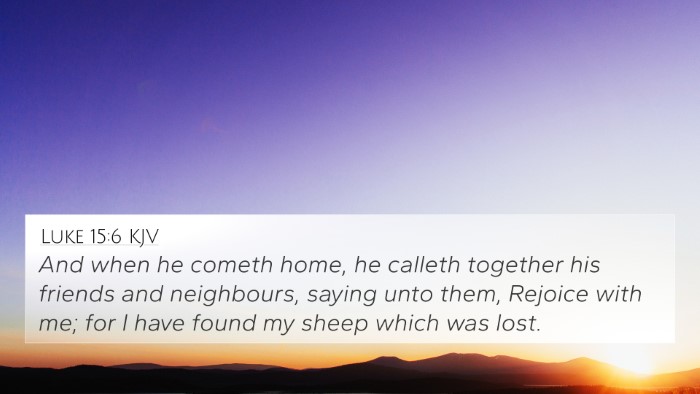Understanding Luke 15:9: A Comprehensive Insight
Luke 15:9: "And when she has found it, she calls her friends and neighbors together, saying, ‘Rejoice with me, for I have found the piece which I lost!’"
This verse is a part of Jesus' parable of the lost coin, illustrating the joy of recovery and the community's participation in celebration.
Summarized Meaning
The primary message of Luke 15:9 encapsulates themes of loss, joy, and communal celebration. The metaphor of the lost coin represents individuals who are lost in sin but are sought after by God. When found, there is not just personal joy, but a call to rejoice with others, highlighting the communal aspect of salvation.
Interpretive Insights from Commentators
-
Matthew Henry:
Henry emphasizes the significance of searching for what is lost and the joy in recovery. He notes that this reflects God's love for sinners and the celebration in heaven for every soul that repents. This joy is not just personal; it extends to the community of believers.
-
Albert Barnes:
Barnes highlights the cultural context of celebrating recovery. He remarks that in biblical times, such a recovery was significant enough to warrant communal rejoicing, thereby reinforcing the importance of fellowship in faith and celebration of God’s grace.
-
Adam Clarke:
Clarke discusses the symbolic meaning of the coin, suggesting it stands for the lost souls of humanity. His analysis connects the joy of finding the coin with the overriding theme of redemption and the nature of divine love, urging believers to partake in the celebration alongside God.
Connections to Other Bible Verses
Luke 15:9 connects with various other Scriptures that reflect similar themes of loss and recovery:
- Luke 15:7: "I say to you that likewise there will be more joy in heaven over one sinner who repents than over ninety-nine just persons who need no repentance."
This verse directly supports the theme of rejoicing over the found, underlining the joy in heaven.
- Isaiah 46:4: "Even to your old age I am He, And even to gray hairs I will carry you! I have made, and I will bear; Even I will carry, and will deliver you."
This highlights God’s continual care in seeking out the lost.
- Matthew 18:12-14: "What do you think? If a man has a hundred sheep, and one of them goes astray, does he not leave the ninety-nine and go to the mountains to seek the one that is straying?"
Another parable illustrating divine search and joy in recovery.
- John 10:11: "I am the good shepherd. The good shepherd gives His life for the sheep."
This underscores the lengths God goes to secure the lost.
- Romans 5:8: "But God demonstrates His own love toward us, in that while we were still sinners, Christ died for us."
This highlights God’s proactive pursuit of the lost.
- Psalm 51:12: "Restore to me the joy of Your salvation, And uphold me by Your generous Spirit."
Expresses the desire for restoration, paralleling the joy experienced when the lost is found.
- 2 Corinthians 5:17: "Therefore, if anyone is in Christ, he is a new creation; old things have passed away; behold, all things have become new."
Reflecting the transformation upon being found.
- 1 Peter 2:10: "Who once were not a people but are now the people of God, who had not obtained mercy but now have obtained mercy."
This illustrates a transition from lost to found.
Thematic Bible Verse Connections
Examining thematic links enhances our understanding of Luke 15:9. The verse's themes of recognition, recovery, and communal joy find resonance throughout Scriptures:
- Community in Salvation: Throughout the Bible, moments of individual salvation are often celebrated communally, as seen in various parables and communal feasts.
- Joy and Celebration: Recurrent themes of joy in recovery and salvation bring forth a theological understanding of God’s heart toward the lost.
- The Pursuit of the Lost: From Genesis through Revelation, God is portrayed as a seeker of those who stray, highlighting His unwavering love and pursuit.
Tools for Bible Cross-Referencing
For deeper analysis, utilize several effective tools:
- Bible Concordance: A comprehensive guide to locate verses and themes efficiently.
- Bible Cross-Reference Guide: Helps in identifying and exploring Jesus’ parables and corresponding scriptures.
- Cross-Reference Bible Study: Engages in thematic exploration of connections between Old and New Testament teachings.
- Bible Chain References: A method of linking themes across verses that aid in understanding broader Biblical narratives.
Connecting Old and New Testament
Identifying connections between the Old and New Testament enhances the understanding of God’s character and the redemptive story:
- The Lost Coin connects to the Old Testament's focus on restoration found in prophets like Jeremiah and Ezekiel, who emphasize God's desire to restore His people.
- Parables echo narratives of lostness, such as Adam's fall and the significance of restitution found within the Law.
Conclusion
In summary, Luke 15:9 serves as a profound reminder of God’s heart for redemption and the joy experienced when one who was lost is found. Through scriptural cross-references, thematic connections, and commentary insights, believers gain a deeper understanding of the Gospel's message about seeking and celebrating the lost.



